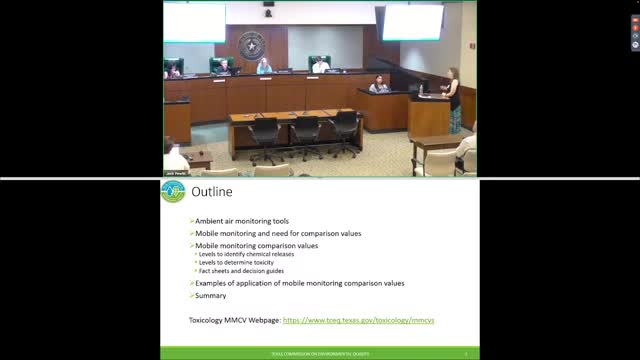New Air Monitoring Tools Set to Revolutionize Safety Standards
July 31, 2024 | Commission on Environmental Quality(TCEQ), Departments and Agencies, Executive, Texas

This article was created by AI summarizing key points discussed. AI makes mistakes, so for full details and context, please refer to the video of the full meeting. Please report any errors so we can fix them. Report an error »

In a recent government meeting, officials discussed the critical role of ambient air monitoring tools and the necessity of establishing comparison values to interpret air quality data effectively. The meeting highlighted the importance of using appropriate averaging times for air quality measurements, emphasizing that a one-hour value cannot be equated with instantaneous concentrations.
The agency has developed mobile monitoring comparison values (MMCVs) to assist staff in identifying chemical releases and assessing potential health risks. These values are derived from toxicity factors that indicate the potency of various chemicals, allowing for the establishment of safe levels in air, water, and soil. The agency has been deriving Air Monitoring Comparison Values (AMCVs) for some time, which serve as benchmarks for evaluating air quality and protecting public health.
A key focus was on the benzene thermometer, which illustrates the significant difference between the agency's one-hour AMCV for benzene at 180 parts per billion and the EPA's acute exposure guideline level of 52,000 parts per billion, demonstrating a substantial margin of safety. The meeting underscored the need for clear communication regarding these values, particularly as they relate to public health and safety.
Officials also addressed the challenges of interpreting instantaneous data collected by mobile monitoring instruments, which can produce highly variable readings over short periods. They stressed the necessity of matching the duration of toxicity factors with the measurement time to ensure accurate assessments of health risks.
The meeting concluded with a discussion on the development of communication tools, including fact sheets and decision guides, to help staff interpret monitoring data and respond appropriately to exceedances of established comparison values. These resources aim to facilitate better understanding among staff and the public regarding air quality issues and the associated health implications.
The agency has developed mobile monitoring comparison values (MMCVs) to assist staff in identifying chemical releases and assessing potential health risks. These values are derived from toxicity factors that indicate the potency of various chemicals, allowing for the establishment of safe levels in air, water, and soil. The agency has been deriving Air Monitoring Comparison Values (AMCVs) for some time, which serve as benchmarks for evaluating air quality and protecting public health.
A key focus was on the benzene thermometer, which illustrates the significant difference between the agency's one-hour AMCV for benzene at 180 parts per billion and the EPA's acute exposure guideline level of 52,000 parts per billion, demonstrating a substantial margin of safety. The meeting underscored the need for clear communication regarding these values, particularly as they relate to public health and safety.
Officials also addressed the challenges of interpreting instantaneous data collected by mobile monitoring instruments, which can produce highly variable readings over short periods. They stressed the necessity of matching the duration of toxicity factors with the measurement time to ensure accurate assessments of health risks.
The meeting concluded with a discussion on the development of communication tools, including fact sheets and decision guides, to help staff interpret monitoring data and respond appropriately to exceedances of established comparison values. These resources aim to facilitate better understanding among staff and the public regarding air quality issues and the associated health implications.
View full meeting
This article is based on a recent meeting—watch the full video and explore the complete transcript for deeper insights into the discussion.
View full meeting
